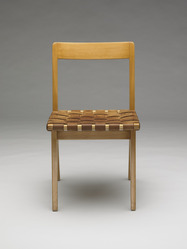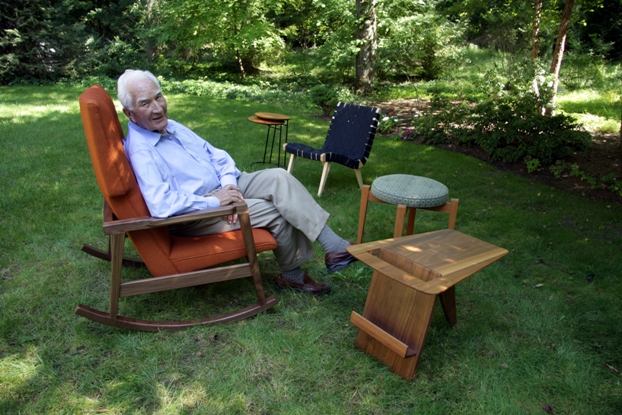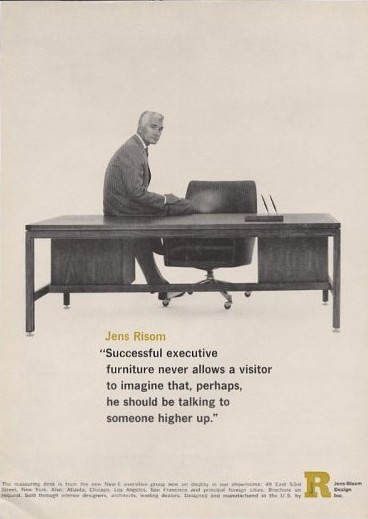By Mary Dunne for Connecticut Explored
In March 1966, Connecticut Governor John Dempsey addressed the national sales meeting of Jens Risom Design, Inc., at its plant in North Grosvenordale, a village of Thompson, Connecticut. He praised Risom and his management team for the vital role they had played in transforming the economy of Northeastern Connecticut, and North Grosvenordale in particular, saying, “We worked hard to fill the textile mills when they closed down, and the Risom Manufacturing Company is an outstanding example of the success of our efforts.” Ten years earlier, the tiny village had been delivered a stunning blow when its only major employer, Cluett-Peabody, abruptly closed its textile mill, began liquidating its assets and left more than a thousand people jobless.
Consumers Captivated by Sleek, Scandinavian-inspired Design
Furniture designer Jens Risom arrived in New York City from Denmark at the age of 23 in 1939. It would not take long for him to be credited as one of the first designers to bring simple Scandinavian furniture design to the United States. In less than two years he established a business relationship with entrepreneur Hans Knoll, and the two set out on a cross-country business trip of sorts, talking with modern architects and exploring the market potential for Risom’s designs. Upon their return to New York, they launched the Hans Knoll Furniture Company, in 1942, with Knoll handling the business end and Risom serving as the primary designer. Risom would design only about 15 pieces of furniture for the first Knoll catalogue before he was drafted into the US Army, where he served under George S. Patton.
Yet those few pieces constituted an impressive contribution, representing 75% of a product line that remains well known and popular today. Known as the “600” line, it included cabinets, bookcases, and an amoeba-shaped coffee table. Perhaps the most recognizable item was the web-seated side chair; manufactured during wartime, when traditional furniture-making materials were scarce, it was constructed with military-rejected parachute webbing.

Side chair, “650 Line” designed by Jens Risom – Yale University Art Gallery, Gift of Jens Risom
After returning from the war, rather than stay on at Knoll as one of a stable of designers, Risom formed his own company in 1946 so that he had complete design, manufacturing, and marketing control. Also, his name, rather than Knoll’s, would be equated with the well-designed and well-crafted contemporary furniture that was becoming increasingly in demand.
In the early 1950s he teamed up with fashion photographer Richard Avedon on a series of advertisements with the tag line, “The Answer is Risom!” “We wanted to hire someone who had never photographed furniture,” Risom said in later years conversation. Avedon said, “I want no interference.” The ads were seductive, featuring only a piece of Risom’s furniture and one or two people in a sensuous pose. Avedon came up with the tag line, and the marketing department at Saks Fifth Avenue created the type font for the ads’ text. The campaign proved so successful that Risom was soon in need of a larger production space and more workers.
Development Commission Lures Design Firm to Connecticut
Thus, the implosion of the local economy in North Grosvenordale, almost simultaneous with the burgeoning popularity of Risom-designed furniture, created a fortuitous opportunity for all concerned. In 1955, the Connecticut Development Commission, in its mission to bring new industry to Connecticut, approached Risom in New York. “It was ideal,” says Risom, referring to the practically turn-key operation with all the space he wanted at 42¢ per square foot and an available local work force. He set up an on-the-job paid apprenticeship and an after-work program to retrain the former textile workers in woodworking and cabinet making. According to Risom, only 2% of his employees had high-school diplomas, so he also set up a program geared toward helping employees earn their GEDs.
The arrival of Jens Risom Design, Inc. was also credited with attracting other industry to North Grosvenordale. The Deran Confectionary Company and Bates Footwear also set up shop in the mill. After selling his business to the Dictaphone Corporation in 1970, Risom started a consulting service, Design Control, in New Canaan, where he lives today. At 93, he remains an active and sought-after designer. In recent years he has modified some of his earlier designs for the furniture retailer Design Within Reach and currently is creating new designs, including his first rocking chair, for Ralph Pucci International.
© Connecticut Explored. All rights reserved. This article originally appeared in Connecticut Explored (formerly Hog River Journal) Vol. 8/ No. 1, Winter 2009/2010.
Note: ConnecticutHistory.org does not edit content originally published on another platform and therefore does not update any instances of outdated content or language.










